Types of water meters: overview of different types + recommendations for buyers
The volumes of water use established by the standards are noticeably overestimated. They are much more than its actual consumption.With the increase in water tariffs, the issue of saving becomes relevant. You can save something only if you keep track of your consumption.
To pay less, you need to install a water meter. But there are so many varieties of this device that it can be difficult to navigate when choosing. You don’t know how the types of water meters offered by different manufacturers differ from each other? We will help you resolve this issue.
The article discusses the types of water meters, their features and operating principles. Photo and video recommendations are provided, and rules for choosing the best option for use at home are listed. Taking into account our advice, purchasing a meter will become extremely simple.
The content of the article:
- Existing types of water meters
- Features of tachometer counters
- Electromagnetic water meters
- Ultrasonic type of devices
- Vortex water meters and their features
- The meaning of inscriptions and symbols on meters
- Tips for choosing a flow meter
- The best counter manufacturers
- Conclusions and useful video on the topic
Existing types of water meters
The correct choice of device for monitoring water consumption cannot be made without knowledge of the characteristics of different types.
Based on the operating principles of the devices, the following types of water meters are distinguished:
- tachometer;
- vortex;
- electromagnetic;
- ultrasonic.
The design of each type has its own characteristics. Let's look at everything in detail.
Features of tachometer counters
This type of water meters is the most common.They operate on a simple principle.
Positive and negative characteristics
Mechanical water meters are compact. They can be installed in remote places, so they do not spoil the interior of the room. The simplicity of the design allows these devices to be priced at an acceptable price for most consumers. The error in their readings is insignificant.

The following characteristics are considered negative:
- blade wear;
- sensitivity to impurities present in water;
- dependence of water meter readings on the magnetic field;
- inability to record instantaneous flow;
- the presence of moving elements in the flow chamber.
Despite the presence of shortcomings, if you follow the verification schedule, the meter can last up to 12 years. The device does not require external power supplies to operate.
Operating principle and design
The main element of the meter is the impeller. It has a perpendicular orientation of its axis relative to the direction of the water supply. The nominal diameter of a device of this type does not exceed 50 mm.
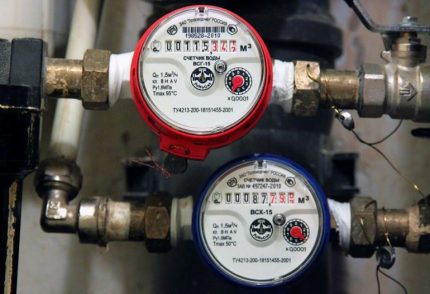
When an avalanche of water transits through the impeller, it moves in a circle. Each is accompanied by the pouring of a certain amount of liquid through the device. The more pressure the water creates, the faster the impeller rotates.
A sensitive counting mechanism receives information about the number of revolutions through the gearbox, and all changes are shown by the dial.
Devices with an impeller can be single-jet, multi-jet, or combined. First, water is supplied to the input blades in one stream. A magnetic coupling sends a torsional impulse to the counting unit indicator. Experts advise installing such meters on hot water pipelines with a cross-section of 15 to 30 mm.
In multi-jet models, the flow is broken into parts on the way to the impeller. The measurement error decreases because the blades are exposed to the same force. In this case, flow turbulence is completely eliminated.
The device is designed for installation on cold water pipes with a maximum diameter of 50 mm. This water meter is ergonomic and easy to install and dismantle if you need to perform verification.
When the coverage of water use measurements needs to be expanded, a combined type tachometer device is installed. It is understood that with a change in the flow rate, one counter comes into operation. The transition occurs automatically.
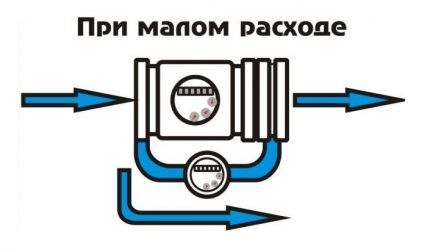
There is only one measuring unit, it is highly accurate and sealed, so it works even in flood conditions. For pipe diameters greater than 50 mm, a rotating turbine is installed in the design of the device instead of an impeller. In this case, the water meter is installed along the axis of the main line. The ideal place to install it is at the entrance.
Such meters are installed on pipelines of industrial enterprises with a cross-section of up to 500 mm, where significant volumes of water flow. The direction and angle of the flow is determined by a special fairing.
Dry and wet-propelled devices
Based on the location of the counting device, tachometer water meters are divided into dry and wet running. In the first case, the liquid has no effect on the counting mechanism. The rotational movement from the impeller is transmitted to it through a special magnetic coupling.
The mechanism is protected from corrosion by an impenetrable partition. The model has a fairly high cost, but it can be used even where hot water is supplied, which contains foreign impurities in large quantities.
In addition, the accuracy of the readings of such a device is very high. If there is a need for remote data acquisition, you can include a pulse output device in the system.
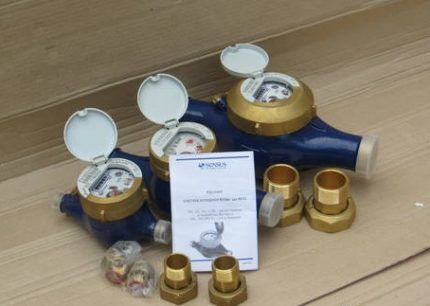
The module collecting information can be located at any distance from the measurement site.
In a wet-flow device, the counting unit is in constant contact with dirty liquid. This negatively affects the duration of its service. To correct the situation, a filter is installed in front of the meter.
Electromagnetic water meters
This type of appliance cannot do its job without electricity. The basis of its functioning is the property of water to pass electric current.
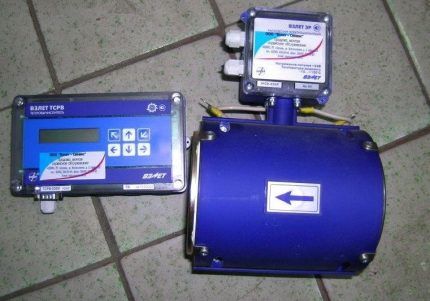
When a liquid overcomes a magnetic field obtained artificially, it changes its parameters, sensors record this, and the data appears on the display. This is an expensive type of meter. It serves well and for a long time if the pipes are free of scale. Because such conditions are rare, electromagnetic devices are used infrequently.
Main pros and cons
If high accuracy of readings is the main advantage of electromagnetic water meters, then the complexity of installation is their main disadvantage. They need a power source. When the electricity goes out, the house will be left without water, since the device will cut off its supply.
The advantages include the following:
- large measurement range;
- absence of moving elements in the flow chamber;
- instant display of consumption;
- data archiving.
Installing a meter does not entail a large increase in resistance to water pressure. For this reason, it is often installed on low pressure pipelines.
Among other disadvantages, it should be noted the uneven distribution of liquid velocity over the diameter of the meter and susceptibility to flow turbulence.
Features of installing an electromagnetic meter
When installing such a meter, you must not forget about filters. They must be present in the system, since the magnet attracts grains of metal present in the water. It’s good if two filters are installed - a standard mud filter and a magnetic one.
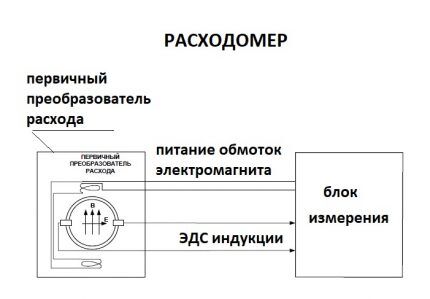
The measuring signal is taken through two electrodes, which are located diametrically and are in contact with water. Mount meters in metal-plastic, metal, plastic pipes in the bathroom and toilet.
Ultrasonic type of devices
These meters are universal, with their help they measure not only water consumption, but also calculate the volume of gas, pair. They, just like electromechanical devices, cannot function without power supply, since they have an electronic counting device, which is simply inoperable without it.
The measurements are carried out by the influence of ultrasonic vibrations on the water flow. The resulting acoustic effect is analyzed by the sensor, and then the readings appear on the display.
They are mounted both on the surface of the water pipe and directly in it. If the installation is performed using the first method, the device can be quickly moved to another location to perform calibration of other meters or temporary control. As a rule, such devices are used in industry.
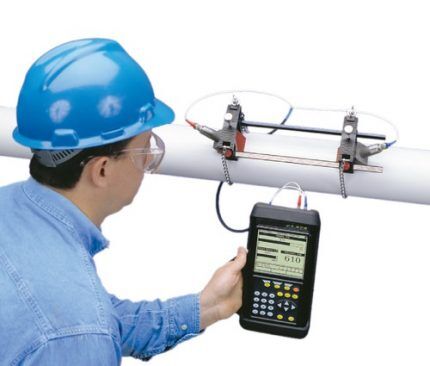
Ultrasonic water meters have low power consumption, which allows them to be used in many areas. The device is well protected from interference. The measurement error with these devices is a maximum of 1%.
The design of such water flow meters does not contain parts that can break, so they practically do not become unusable.The latest models of such types of water meters as ultrasonic ones successfully combine good metrological qualities, accuracy and appropriate cost.
They are equipped with lithium batteries that maintain their performance for more than 5 years. They also provide automatic adjustment at certain time intervals, which raises the measurement accuracy to a higher level.
The disadvantages of the equipment include the need for an external power supply or autonomous. Another negative point is that the measurement accuracy is reduced due to the presence of air bubbles in the water.
Vortex water meters and their features
Vortex meters can operate stably only if the water in the pipeline is clean and free of abrasive particles that can distort the readings.
Each vortex counter contains a streamlined body. It is placed in a pipe and acts as an obstacle to the flow of water. Further along the flow direction there is a highly sensitive sensor. It reacts to the slightest pressure fluctuations in the flow.
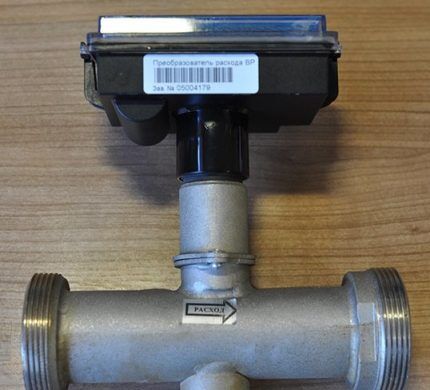
When the speed of a moving fluid reaches a certain value, vortices appear outside the obstacle. They are formed alternately from different sides and move with the flow. In this case, zones of low and high pressure appear. This gives rise to a phenomenon called a “vortex street.”
Vortexes appear with a frequency proportional to the speed of the moving flow. The distance between adjacent vortices corresponds to the volume of water flowing during the corresponding period.Therefore, the flow rate can be calculated by multiplying the number of vortices by the volume. The higher the flow speed, the more often vortices occur.
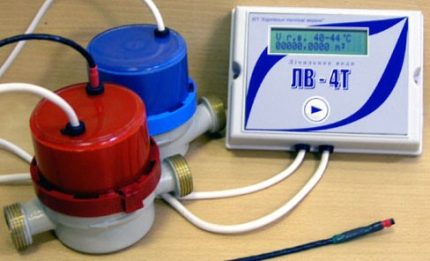
The average service life of the device is 8 years. The main purpose is to regulate technological processes. IN plumbing in the apartment It is irrational to use such devices.
The meaning of inscriptions and symbols on meters
Symbols and inscriptions on water meters can tell a lot about the device. Therefore, you need to learn to decipher them in order to find out certain capabilities of the product and determine which meter is suitable for specific conditions.
Manufacturers put four main designations on devices:
- Qmax — maximum flow rate that does not cause errors in the operation of the device. The device can operate at this flow rate for a maximum of 1 hour. This must be followed by a break.
- Qn — optimal flow rate for a water meter. In relation to its maximum capability, this parameter is 50% less. In the case when a volume of water equal to the normal flow rate passes through the body of the device, it will function flawlessly. The device will be able to pass verification and will not have to be replaced with a new one for a long time.
- Qmin - the lowest flow rate, which gives the smallest error when measuring water flow.
- Qt - pressure at which it is unprofitable to operate a water measuring device, since it begins to operate with a significant error. At the same time, it is difficult to predict what sign the error value will have - it can be either a minus or a plus to the actual readings.
In addition to these designations, the maximum temperature at which the device can operate is marked on the body of the water meter.
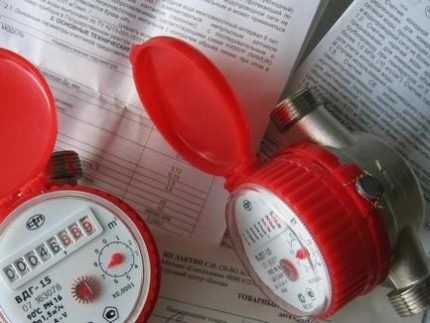
Cold water flow meters have the inscription 40 °C and the housing is blue. The casing of flow meters for hot water is red or, which is much less common, black. On this background there will definitely be the inscription 90 °C.
If water whose temperature exceeds 90 °C is centrally supplied under pressure, you need to select the meter marked 150 °C.
Tips for choosing a flow meter
Knowing what water meters are available for sale, when choosing, you need to decide on the purpose of installing the meter. If its installation is necessary in order to know how many cubic meters of cold water have been consumed, expensive meters are not needed.
A simple “wet” tachometer option is quite suitable here, you just need to first agree with the water supply company about its class.
A tachometer water meter is also suitable for a pipeline with hot water, but in a “dry” version so that the impurities in the water do not damage the measuring module. For a system where the flow is characterized by sudden changes, it is better to choose a combination device.
The lower the permissible error, the higher the accuracy class of the meter. This parameter increases from "A" before "D". Devices used in everyday life have an accuracy class "IN", if they are oriented for horizontal installation. For vertical installation, “A” class is acceptable. Class "WITH" typical for electronic meters installed in any position.
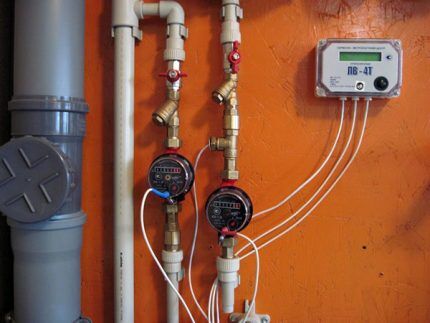
Taking into account the technical side when choosing a meter is mandatory, but it is equally important to take into account the fact that the device matches the location in which you want to install it.
If the device needs to be hidden in a niche, under the toilet or under the bathtub, then you should definitely think about what shape of the housing will “fit” into the free space. In one case, a device with a short body is suitable, in another - an elongated one.
The orientation of the counter relative to the floor is also important when choosing. It can be positioned vertically or horizontally. The main thing is that the data is easy to read. If the device’s counting mechanism is oriented horizontally, then the product itself should occupy this position.
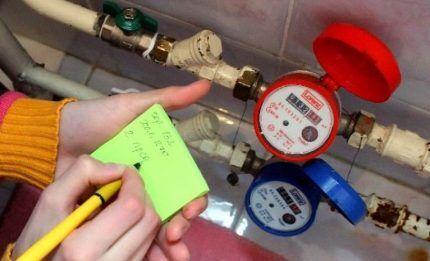
There are water meters whose digital display is located in such a way that readings can only be taken if it is mounted vertically. Since hot and cold water have different prices, payments are made to different bills.
The best counter manufacturers
The market is rich in water meters, both domestic and imported. Among the domestic manufacturers, the best are considered:
- "Betar";
- "Economy";
- "Meter"
- "Staroruspribor";
- "Triton".
The devices of these companies are cheaper than foreign ones and cope well with the tasks assigned to them. The main thing is that they are adapted to our realities to the maximum.
Among the imported models, the following have won the greatest consumer trust:
- Zenner (Germany);
- Wehrle (Germany);
- Actaris (France);
- Viterra (Germany);
- Siemens (Germany).
They have a large calibration interval and traditionally high reliability. We must not forget the fact that they are designed for water of a higher quality than that which flows in our water pipes.
Therefore, you need to be prepared for breakdowns, so it doesn’t hurt to find out if there are service centers nearby.
Conclusions and useful video on the topic
Video #1. Why are counters needed and their main types:
Video #2. Water meter brands. Which device is better:
Purchasing a water meter is an additional expense, but it is completely justified. What you spend will soon not only pay off, but will also allow you to save considerable amounts on water bills.
The main thing is to purchase water meters produced by a trusted manufacturer. A cheap water meter of poor quality usually has a large error and you will have to pay extra.
Would you like to tell us about how you selected a water meter for your own apartment? Share which model you chose and why. Please leave comments, ask questions and post photos related to the topic of the article in the block below.




In my opinion, the problem is not that serious. For an apartment or residential building, you can and should choose the simplest tachometer counters. They are very inexpensive, installation is simple, you can do it yourself. The main thing is to look at the arrow, which indicates the direction of water flow. Well, a filter with a check valve is a must. That's all! Simple and working design. And everything else is from the evil one. Well, someone would explain to me: why install an electromagnetic or vortex, ultrasonic meter in an apartment if they also provide electricity? Is this practical? Of course not.
Is the electromagnetic meter difficult to install? I am currently only looking at this type of counter, but have not yet decided on the model. Does it make sense to buy a more expensive meter from a well-known imported manufacturer, or will the cheaper one also serve well? The prices are just different there, maybe someone can recommend some inexpensive but high-quality option.
Do you need it? No seriously. If you take the electromagnetic one, then it doesn’t matter whether it’s ours or an imported one. Thank God we have learned to assemble the simplest equipment with high quality. He just has a lot of mistakes. Firstly, it is expensive, and secondly, it requires electricity. In general, the lights will be turned off, and you will be left without water. Need precision? Take a tachometer dry counter and don’t worry.
Hello. Please read the relevant article on the website - https://engineering-en.techinfus.com/vodosnab/filtr-schet/luchshie-schetchiki-xolodnoj-i-goryachej-vody.html
For several years now, the apartment has had hot and cold water meters. There are tachometer counters. The first flow meters served for five years and were replaced with new ones a year ago. As I understand it, such meters can last much longer. However, the water flowing through the pipes is very hard and contains various impurities. And I always follow the schedule for checking meters, I don’t put it off.
Are there hot water meters that start flowing at a certain temperature? The problem we have is that we have to drain the water for a long time to get hot water, sometimes up to half an hour with the tap open as much as possible, while the meter spins furiously.Utilities aren't doing anything, so how about using meters like these to get them to move?